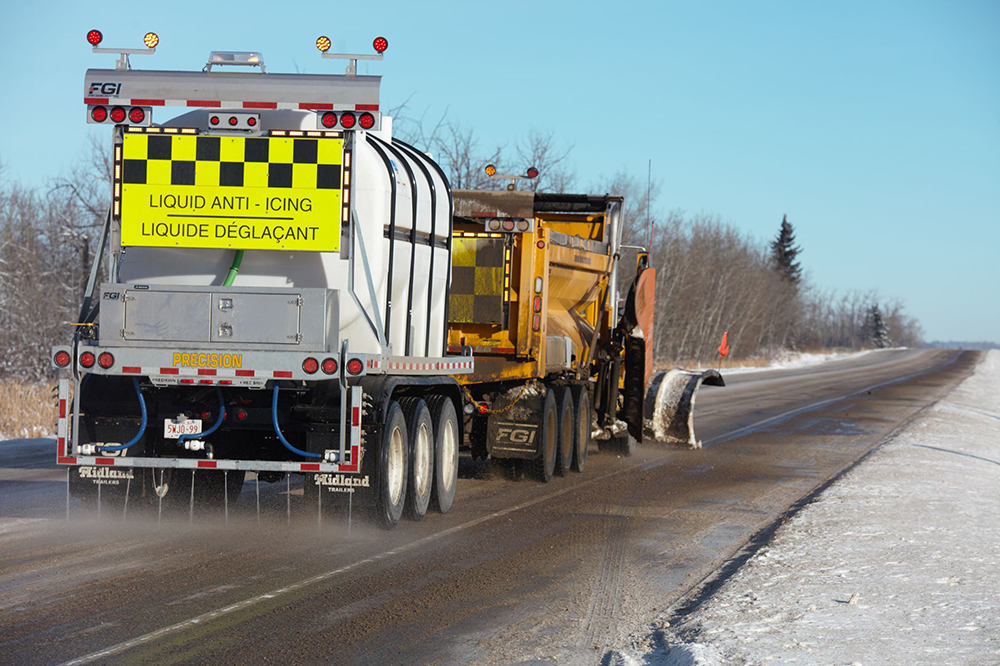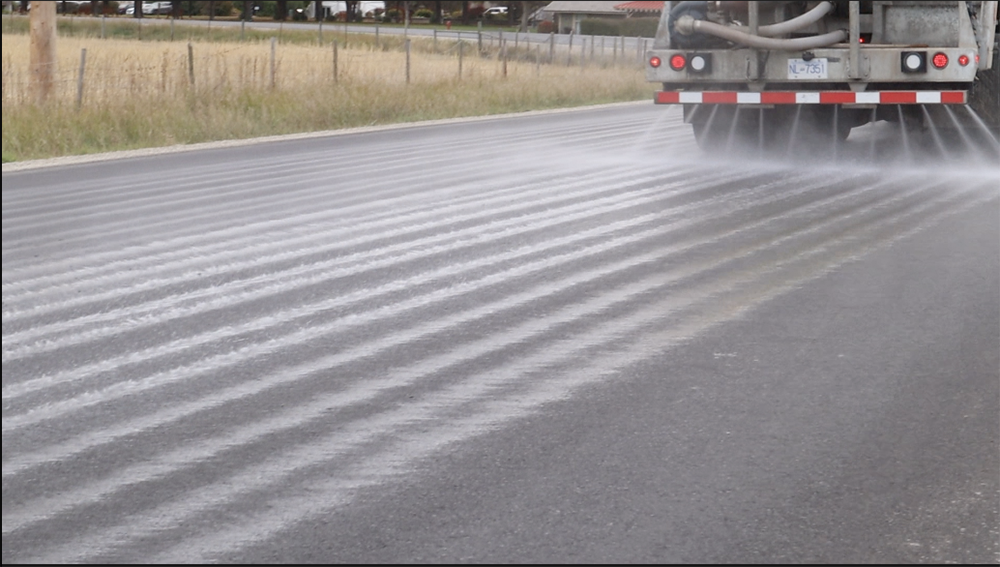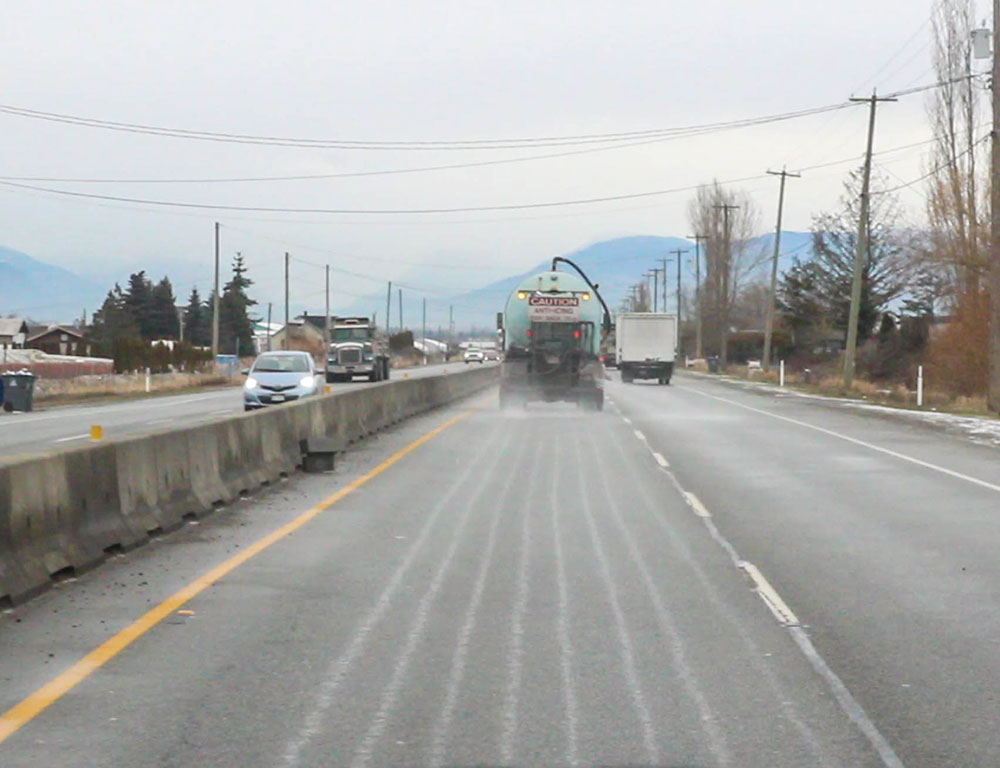Mainroad Liquid Anti-Icing Brine Program | FAQs
When it comes to preparing roads for winter, being proactive is the key to prevention. Like many road crews across North America, Mainroad uses liquid brine as one of its winter tools, which is an advanced practice to immediately combat icy roads. Mainroad recognizes that the use of liquid anti-icing brine is still a new winter highway maintenance method to some people – here are some answers to common questions.
How does Mainroad prepare for a winter storm event?
Prior to a winter storm event, Mainroad crews will be patrolling service area highways and roads while monitoring the forecast closely. Mainroad’s pre-storm activities typically include pre-salting/brining and monitoring the forecast closely. The use of liquid anti-icing brine is a proactive and proven way of combatting ice from forming on the highway surface. This technique is used throughout most highway maintenance jurisdictions in North America and Europe.
What materials does Mainroad use for winter road maintenance?
Mainroad uses three materials for winter road maintenance:
- winter abrasives (also known as winter sand)
- granular salt. Salt is a staple of our winter maintenance routine and can be used in a granular form or liquid form.
- liquid anti-icing brine solution
The use of a specific material is determined by the weather forecast, road temperatures, actual weather conditions and in accordance with the specifications set by the Ministry.
What is liquid anti-icing brine?
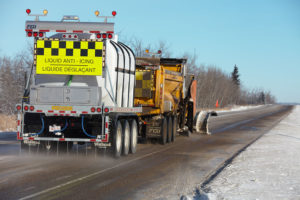 Anti-icing brine is a blend of crystal salt and water. Typically, it’s a mixture of 23% crystal salt with 77% water. For comparison, ocean water is 3.5% on average. Depending on the forecasted weather event, anti-icing brine can also be a blend of chlorides that suite colder temperatures. Road temperatures and other atmospheric conditions will dictate what anti-icing brine solution will be used.
Anti-icing brine is a blend of crystal salt and water. Typically, it’s a mixture of 23% crystal salt with 77% water. For comparison, ocean water is 3.5% on average. Depending on the forecasted weather event, anti-icing brine can also be a blend of chlorides that suite colder temperatures. Road temperatures and other atmospheric conditions will dictate what anti-icing brine solution will be used.
Brine is a preventative material that is applied to the road surface prior to snowfall or frost. The brine dries on the road surface and provides early snow melting capabilities. The use of liquid anti-icing brine is a proactive and proven way of combatting ice from forming on the highway surface. This technique is used throughout most highway maintenance jurisdictions in North America and Europe. Mainroad has been using liquid anti-icing within its operations since 1998. During this time Mainroad has performed various trials based off of best practices within the highway maintenance industry to ensure we remain at the cutting edge of technology.
When is liquid anti-icing brine applied to the road surface?
The decision to use liquid anti-icing brine and when to use it is based on many factors. Mainroad knows that preparation is key. We have actively practiced the liquid anti-icing brine method for two decades in high volume traffic areas such as the South East Stoney Trail in the Province of Alberta, and in British Columbia’s Lower Mainland and East Kootenay regions.
To be an effective and safe solution, there is a specific time and application rate for liquid anti-icing brining. Service Area weather forecast, road and air temperatures, and the current temperatures of the pavement are all factors to be considered. Typically, liquid anti-icing brine is used during the shoulder season between fall and winter when dew and fog can create ice and temperatures are less extreme.
Prior to a winter storm event, a thin layer of liquid anti-icing brine solution is applied to the road surface to prevent any snow or ice from sticking/bonding to the surface of the roadway.
Whatever approach is taken to respond to a winter storm event, motorists need to drive for the conditions regardless of the posted speed limit.
Why use liquid anti-icing brine vs. granular salt?
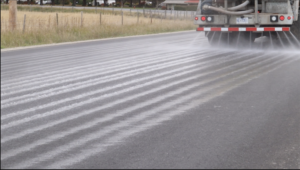 Mainroad’s aim is to increase the level of service to motorists. By using liquid anti-icing brine, we can get the roads back to bare and black conditions as per highway maintenance specifications much more quickly than using a granular material alone.
Mainroad’s aim is to increase the level of service to motorists. By using liquid anti-icing brine, we can get the roads back to bare and black conditions as per highway maintenance specifications much more quickly than using a granular material alone.
Instead of applying crystal salt and waiting for it to liquify when mixed with the road surface moisture, we speed up the process by applying this already liquified product.
The use of liquid anti-icing brine is an effective solution in preventing ice from forming on the road surface versus the use of granular salt. Brine will stick to the road and travelling lanes while granular salt will blow away or be pushed off the roadway by moving vehicles. Using salt as a component of liquid anti-icing brine is using a natural resource rather than a manufactured chemical. In order to work effectively, granular salt needs to liquify which takes some time, compared to a brine solution which begins to work immediately on the road surface.
Liquid anti-icing brine melts snow and ice by lowering the freeze point of water —snow and ice will keep melting when it comes in to contact with the brine. Using liquid anti-icing brine enables Mainroad to be precise in our response to specific conditions on the road surface where the use of granular salt may be more limited.
Better for the environment!
Mainroad is doing its job to reduce the impact to the environment. What we put on the highway, stays on the highway—that results in less waste and impact to the environment. Mainroad’s liquid anti-icing brine program also reduces the use of winter sand. With less sand blowing in the air, it helps to improve the air quality throughout the winter and spring and reduces the migration of sand forming silt into our waterways.
Are there other ways that anti-icing brine can be used during winter operations?
Brine can also act as a de-icing agent during a storm or once a storm has passed and can help to remove packed snow and ice from the road surface. After snow has been cleared, liquid anti-icing brine is an important component in Mainroad’s plan to prevent ice from forming as it breaks down the bonding ability of ice on the road surface.
How will I know that Mainroad has applied liquid anti-icing brine to the roads and highways?
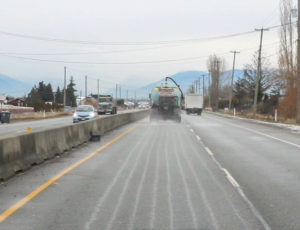 Chalky white lines will dry on the road surface as evidence that the brine has been applied. When the lines are in contact with first moisture such as snow, the brine will begin to work immediately in melting snow and ice on the road surface.
Chalky white lines will dry on the road surface as evidence that the brine has been applied. When the lines are in contact with first moisture such as snow, the brine will begin to work immediately in melting snow and ice on the road surface.
Aren’t there ways to melt snow faster?
There are ways to melt snow and ice faster through the use of a pure calcium chloride brine solution, however Mainroad chooses not to use straight calcium because it poses a higher risk to the environment.
Mainroad uses a blended solution when the situation arises (below minus 5 degrees celsius).
Is salt brine going to rust my car?
The amount of salt Mainroad uses in a brine solution is less in volume when covering the same amount of roadway surface vs granular salt.
The use of anti-icing brine is an effective solution at preparing for a winter weather event because it bonds instantly to the pavement, ready for any ice or snow to come into contact with the road surface. Anti-icing brine will stick to the road and travelling lanes while granular salt tends to blow away or be pushed off the roadway by moving vehicles even when travelling at low speeds.
Driver Tip: Wash your vehicle with soap and water after winter storms and at the end of winter, to remove residue from brine, sand and salt. Be sure to spray underneath too!
Learn more at TranBC’s blog: Revealing the Anti-icing and De-icing Magic of Brine
Remaining safe is a joint responsibility, when you see Mainroad highway maintenance vehicles and equipment on the road, please proceed with caution, we’re packing a lot of weight.
Our eyes are on the road, observing winter events, obstacles and dangers. We ask you to be patient. Give highway maintenance equipment plenty of space— about 10 car lengths— especially when we are performing snowplow operations and/or applying crystal salt, liquid anti-icing brine or winter sand materials.
Never pass on the right and only on the left when it is safe and legal to do so.
Safety is Mainroad’s highest priority. It is with commitment and care that our employees are working towards the goal of making the roads safe to travel for everyone.
